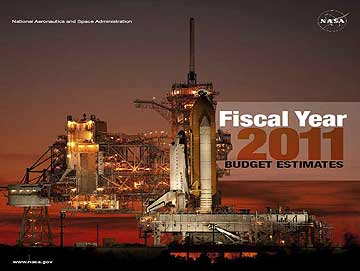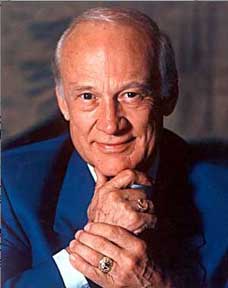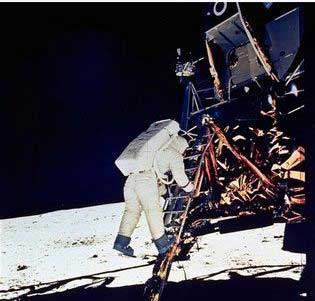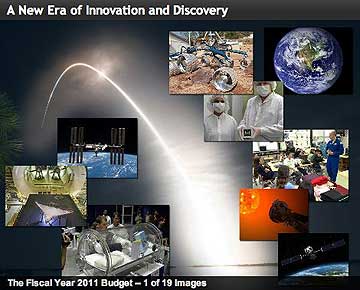
- The Office of Science and Technology Policy that summarizes the budget with seven bulleted items, that, when the link is accessed, are expanded upon.
- Statements from Astronaut Buzz Aldrin: A New Direction in Space
- Norman R. Augustine, retired chairman and CEO of Lockheed Martin Corp.
- Office Of Management And Budget — National Aeronautics and Space Administration
Office of Science and Technology Policy
National Aeronautics and Space Administration
FACT SHEET
A Bold New Approach for Space Exploration and Discovery
- Adds $6 billion to NASA’s budget over five years and draws upon American ingenuity to enable us to embark on an ambitious 21st century program of human space exploration and observation of the Earth and the Universe.
- Ends NASA’s Constellation program, which was planning to use an approach similar to the Apollo program to return astronauts to the Moon 50 years after that program’s triumphs. An independent panel found that Constellation was years behind schedule and would require large budget increases to land even a handful of astronauts back on the Moon before 2030. Instead, we are launching a bold new effort that invests in American ingenuity to develop more capable and innovative technologies for future space exploration.
- In consultation with our partners, extends operation of the International Space Station likely to 2020 or beyond and enhances its utilization, bringing nations together in a common pursuit of discovery in space.
- Initiates several new programs to transform the state of the art in space technologies, including flagship exploration technology development and demonstration programs, investments in early-stage advanced concepts, potential “game-changing” technologies, and new propulsion technologies – all intended to increase the reach and reduce the costs of future human space exploration as well as other NASA, government, and commercial space activities.
- Enhances the Nation’s global climate change research and monitoring system, accelerating decadal survey missions and re-flying a satellite that will identify global carbon sources and sinks. Expands NASA’s aeronautics efforts to bring cleaner, safer, and more efficient transportation to our skies.
- Directs NASA to partner with the aerospace industry in a fundamentally new way, making commercially provided services the primary mode of astronaut transportation to the International Space Station. This new policy harnesses our nation’s entrepreneurial energies, and will create thousands of new jobs and catalyze the development of other new businesses that capitalize on affordable human access to space.
- Provides for a robust program of robotic solar-system exploration and new astronomical observatories, including a probe that will fly through the Sun’s atmosphere and an expanded effort to detect potentially hazardous asteroids. The entire four page document can be found here.
- Research and development to support future heavy-lift rocket systems that will increase the capability of future exploration architectures with significantly lower operations costs than current systems – potentially taking us farther and faster into space.
- A vigorous new technology development and test program that aims to increase the capabilities and reduce the cost of future exploration activities. NASA, working with industry, will build, fly, and test in orbit key technologies such as automated, autonomous rendezvous and docking, closed-loop life support systems, in-orbit propellant transfer, and advanced in-space propulsion so that our future human and robotic exploration missions are both highly capable and affordable.
- A steady stream of precursor robotic exploration missions to scout locations and demonstrate technologies to increase the safety and capability of future human missions and provide scientific dividends.
- $369 million for a new agency-wide technology development and test program aimed at increasing the capabilities and reducing the cost of future NASA, other government, and commercial space activities.
- $183 million to extend operations of the ISS past its previously planned retirement date of 2016. NASA will deploy new research facilities to conduct scientific research and test technologies in space. New capabilities could include a centrifuge to support research into human physiology, inflatable space habitats, and a program to continuously upgrade Space Station capabilities.
- $600 million to complete the final five shuttle missions, allowing for a safe and orderly retirement of the Space Shuttle program even if its schedule slips into Fiscal Year 2011.
- $1.2 billion for transformative research in exploration technology that will involve NASA, private industry, and academia, sparking spin-off technologies and potentially entire new industries.
- $150 million to accelerate the development of new satellites for Earth Science priorities.
- $170 million to develop and fly a replacement of the Orbiting Carbon Observatory, a mission to identify global carbon sources and sinks that was lost when its launch vehicle failed in 2009.
- $500 million to contract with industry to provide astronaut transportation to the ISS, reducing the sole reliance on foreign crew transports and catalyzing new businesses and significant new jobs. Increases Scientific Understanding of the Solar System and Universe
- $3.2 billion for science research grants and dozens of missions and telescopes studying the planets and stars – including new missions such as the successor to the Hubble Space Telescope, missions to study the Moon, and two Mars exploration missions.
- $14 million ($420 million over five years) for a mission to the Sun, flying through its outer atmosphere to better understand how it is heated and how it ejects the stream of charged particles known as the solar wind.
- Increase funding to detect asteroids that could potentially pose a hazard to the Earth.
- Increase efficiency and throughput of aircraft operations during arrival phase of flight.
- Make significant progress towards completion of the integration, test, launch, validation, and initiation of early orbit operations of the Aquarius, Glory, and NPOESS Preparatory Project (NPP) missions prior to the end of Fiscal Year 2011.
- Increase annually the percentage of NASA higher education program student participants employed by NASA, aerospace contractors, universities, and other educational institutions.

Statement from Buzz Aldrin: A New Direction in Space
Today I wish to endorse strongly the President’s new direction for NASA. As an Apollo astronaut, I know the importance of always pushing new frontiers as we explore space. The truth is, that we have already been to the Moon – some 40 years ago. A near-term focus on lowering the cost of access to space and on developing key, cutting-edge technologies to take us further, faster, is just what our Nation needs to maintain its position as the leader in space exploration for the rest of this century. We need to be in this for the long haul, and this program will allow us to again be pushing the boundaries to achieve new and challenging things beyond Earth. I hope NASA will embrace this new direction as much as I do, and help us all continue to use space exploration to drive prosperity and innovation right here on Earth.
I also believe the steps we will be taking following the President’s direction will best position NASA and other space agencies to send humans to Mars and other exciting destinations as quickly as possible. To do that, we will need to support many types of game-changing technologies NASA and its partners will be developing. Mars is the next frontier for humankind, and NASA will be leading the way there if we aggressively support the President’s plans.

FILE - In this July 20, 1969 file photo, astronaut Edwin E. Aldrin, Jr., lunar module pilot, descends steps of Lunar Module ladder as he prepares to walk on the moon. A California preservation panel has taken the unusual step of naming the Apollo 11 moon landing site as a state historical resource, according to a report Friday, Jan. 29, 2010. NASA, FILE / AP PHOTO
Finally, I am excited to think that the development of commercial capabilities to send humans into low earth orbit will likely result in so many more earthlings being able to experience the transformative power of spaceflight. I can personally attest to the fact that the experience results in a different perspective on life on Earth, and on our future as a species. I applaud the President for working to make this dream a reality.
Buzz Aldrin, Feb. 1, 2010 This statement is available at.

In 2009, I had the honor of leading a committee comprised of individuals with extensive experience in space activities in an assessment of NASA’s human spaceflight program and plans. We found that the current Constellation program was unsustainable and was highly unlikely to get humans to the International Space Station before its planned de-orbit or back to the Moon until roughly 20 years in the future. The root cause has been an incompatibility of funding resources and work scope in the human spaceflight program, a situation that has persisted for a number of years.
Our committee was specifically not tasked to make recommendations but rather to consider alternative paths going forward. In an effort to maintain an unfettered perspective we held no discussions on an overall preferred option. The plan released with the President’s FY 2011 budget does appear to respond to the primary concerns highlighted in our committee’s report. By extending the ISS to 2020, NASA and our many international partners will be able to capitalize on the full capability of this unique orbiting laboratory. By making a significant investment in creating commercial capabilities to take humans and cargo to low-Earth-orbit, overseen from a safety-standpoint by NASA, will drive competition, lower costs, open new markets and make space more accessible. Similarly, by allocating the technology resources highlighted in our report as being necessary, it will be possible to lay the foundation for travel beyond low-Earth-orbit, including destinations such as the asteroids, the Lagrangian points, Mars’ moons and Mars itself, as well as revisits to our own Moon. NASA will be able to focus on this true frontier and to regain its position as a cutting-edge research and development organization.
While many of us who believe strongly in human spaceflight might have hoped that still further funding would have been possible, this is obviously a demanding period from a budgetary standpoint. Importantly, the President’s proposed program seems to match means to ends, and should therefore be executable. Our committee had the occasion to meet many of the highly dedicated leaders in NASA and industry who are pursuing the human spaceflight program and we were very impressed with their technical capabilities and their commitment to the success of America’s space program. While human spaceflight for the next few years will focus on near-Earth activities, I remain fully confident that given adequate, sustained funds these individuals can successfully create a strong next-generation human space exploration program.
Augustine's speech is avalable at.

The National Aeronautics and Space Administration (NASA) drives advances in science, technology, and exploration to enhance knowledge, education, innovation, economic vitality, stewardship of the Earth, and solutions to national and global challenges. The President’s Budget invests an additional $6 billion in NASA over the next five years – an overall $100 billion commitment to the agency. FY2011 Request: $19.0 billion FY2010 Enacted: $18.3 billion.
Build the Foundation for a Bold New Course for Human Space Flight
NASA’s Constellation program — based largely on existing technologies — was based on a vision of returning astronauts back to the Moon by 2020. However, the program was over budget, behind schedule, and lacking in innovation due to a failure to invest in critical new technologies. Using a broad range of criteria an independent review panel determined that even if fully funded, NASA’s program to repeat many of the achievements of the Apollo era, 50 years later, was the least attractive approach to space exploration as compared to potential alternatives. Furthermore, NASA’s attempts to pursue its moon goals, while inadequate to that task, had drawn funding away from other NASA programs, including robotic space exploration, science, and Earth observations.
The President’s Budget cancels Constellation and replaces it with a bold new approach that invests in the building blocks of a more capable approach to space exploration that includes:
Expand America’s Drive to 21st Century Space Exploration
High-Priority Performance Goals
The Administration is committed to building a transparent, high-performance government capable of addressing the challenges of the 21st century. As part of developing the budget, every department identified high-priority performance goals (along with the strategies and in-house resources to achieve them) that each will work to accomplish over the next two years. Highlights of this agency’s currently identified goals are:
To see the Department’s full set of performance information, please visit. Given the new investments identified in the President’s FY 2011 budget for NASA, additional high-priority performance goals are expected to be formulated in the near future.

